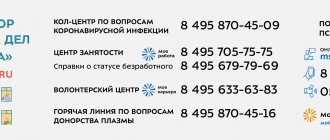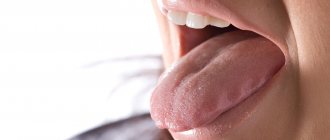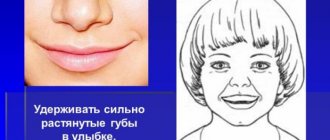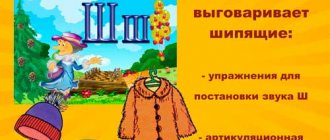Features of articulation
The problem of incorrect sound pronunciation (if the child does not have other speech problems, for example, dysarthria) of sonorant sounds is the difficulty in their articulation. This is especially true for R, so speech therapists advise parents not to panic if their child does not “growl” at three years old. The articulatory apparatus must be prepared, which happens by the age of 4-5, so be sure to do articulatory gymnastics with your child.
When pronouncing P, the organs of the articulatory apparatus occupy the following position:
- the mouth is open, the lips are in the position of the vowel sound following P;
- the tongue should be wide, located behind the upper teeth and touching the alveoli, the lateral edges should be raised; it is shaped like a small ladle;
- the soft palate is raised;
- vocal cords vibrate.
In addition to the correct position of the organs of the articulatory apparatus, a strong air stream is needed, because when exhaling it is directed to the tip of the tongue, resulting in its vibration and a “rumbling” sound.
The tip of the tongue should vibrate, not the small tongue or its side. You can check the direction of the air stream using a strip of paper: if pronounced correctly, it will sway.
Why is it difficult to growl?
The sound "r" is considered one of the most difficult to reproduce. To pronounce it correctly, you need:
- raise the tip of the tongue to the upper teeth - while it should remain spread out, like a pancake, and not narrow from tension;
- As you exhale, direct a powerful air stream to the tip so that vibration occurs.
For such manipulations, the child needs a developed speech apparatus, a strong tongue root and frenulum. Usually all this is formed by the age of six.
Types of violations
Violation of the pronunciation of the sounds R and R` is called rhotacism and pararotacism.
There are several options:
- Absence of sound in speech - the child does not use another sound instead (for example, “cow” instead of “cow”).
- Velar - occurs when the back of the back of the tongue rises too much and comes into contact with the soft palate. As a result, a gap is formed and when air passes through it, the walls of the sky create additional noise, which distorts the pronunciation of sound. This disorder is called burr.
- Uvular - only the small tongue vibrates. This type of rotacism is called throat rhotacism.
- Side – the side edge vibrates. When pronounced, the sounds R and L` are combined.
- Bilibial - this type of disorder is rare. The child creates a vibration with his lips and produces a sound similar to “prrr”.
- Labiodental - the sound is produced between the upper lip and lower teeth, and vice versa.
- Single-beat or proto sound - the tip of the tongue makes only one blow on the alveoli, and long vibrations are not obtained. The pronounced sound has a D sound; the child cannot pronounce the long, rolling R.
- Buccal - the air stream passes through the cheek and lateral edges of the tongue, which causes vibration of the cheeks.
- Interdental - the tongue is located between the teeth.
- Laryngeal - the sound P occurs as a result of strong tension of the vocal cords.
Pararotacism is the replacement of one sound with another. The sound R is often replaced with its soft version, or replaced with L, which is simpler in articulation.
This sound is also replaced by the following sounds:
- B - “pavahod” instead of “parachod”;
- D – “duca” instead of “hand”;
- G – “pagavoz” instead of “paravoz”;
- Y – “yiba” instead of “fish”.
Rhotacism may be a reflection of simple dyslalia, when the pronunciation of one sound is impaired. Or is it a variant of complex dyslalia, when the sound pronunciation of several groups of sounds is impaired. Rotacism and pararotacism may indicate more complex speech disorders - dysarthria, alalia, rhinolalia.
How can a child distort "R"
Incorrect “r” sounds are called rhotacism - these are the sounds that are replaced instead of this letter. Before determining exercises for producing the sound R, it is necessary to understand exactly how the child pronounces this sound. It happens like this:
- Burr or speaking through the throat. When pronounced, the palate vibrates instead of the tip of the tongue. A similar phenomenon is more typical for French, but not for Russian.
- Lateral "R". This happens if the side is pressed against the upper jaw, the opposite side hangs down. In this case, the tip cannot vibrate, and the sound P itself is more similar to “rl”.
- Single-stroke "r". Instead of shaking, the tip hits the roof of your mouth. This is how the English letter “R” is pronounced.
- Pronunciation through the nose. The air flow must pass through the mouth.
- Kucherskoe R. The tongue vibrates on the pressed lips, resulting in the sound “tpr”, not a pure R.
- Pararotacism. This is the phenomenon of replacing the sound P with another, for example G.L,V.
- Pass. The child simply does not pronounce this sound at all and misses it in his speech.
Reasons for violations
Why does a child have a problem with the pronunciation of R? There are several reasons, and to eliminate some of them you need the help of several specialists, not just a speech therapist:
- Anatomical features. These include a shortened hyoid frenulum, cleft lip, palate, and malocclusion.
- The air stream is not strong enough.
- Incorrect position of the organs of articulation - there are no anatomical disorders, but, for example, the tongue is in the wrong position because the child did not remember the correct articulation.
- Incorrect speech environment - often parents worry that if they burr, then their children will pronounce R incorrectly. This is not a genetic predisposition, but an incorrect speech environment. The child hears the incorrect pronunciation and tries to copy it. This is why rotacism arises.
- The child does not distinguish sounds by ear - this is a violation of the phonetic processes.
In addition, if there is a complex speech disorder - alalia, then incorrect sound pronunciation may be a consequence of insufficient activity of the speech areas of the brain. It is important to determine the exact cause of rhotacism and pararotacism in order to draw up a plan for corrective work.
Speech therapy diagnostics
To determine whether there is a violation of the sonorous group, you need to select speech material. But the examination begins with checking the articulatory apparatus. The specialist pays attention to their anatomical structure. Then evaluates the work using exercises (for example, raising and lowering the tongue).
The speech therapist checks speech breathing. To do this, he asks the child to play wind instruments (pipes); blow on a piece of cotton wool. Thus, the specialist watches how the child inhales and exhales and the force of exhalation.
The sound R must be present in forward and backward syllables, at the beginning, middle and end of the word. You also need to select syllables with a combination of consonants (for example, TRA, KRA and others). It happens that a child can pronounce R and R` paired with consonants - it is important to reflect such moments in speech therapy diagnostics.
You also need to check phonetic processes: the speech therapist calls the child isolated sounds and asks him to clap his hands or raise his hand to the desired sound. Then they also check P in syllables and words. The speech therapist shows the child pictures and asks to see the image that has R in the name.
In addition to speech diagnostics, the specialist conducts a conversation with parents to understand the environment in which the child is growing up. Because if there are adults around who burr or have other types of rhotacism and pararotacism, they need to correct their speech when communicating with him, try to use fewer words with the corrected sound.
Based on all the collected data, the speech therapist draws up correctional work. If necessary, he advises you to contact other specialists to get comprehensive help and achieve results.
What specialist help may be needed?
If the cause of a speech defect in a child is a shortened hyoid frenulum, then consultation with a surgeon may be required. But in modern speech therapy they solve this problem with the help of exercises. And only those who have a too short frenulum need the help of a surgeon. This defect makes it difficult to raise the tongue, which is the basis for the pronunciation of R.
If your bite is incorrect, your speech therapist may advise you to see an orthodontist. If there is a complex speech disorder (dysarthria, alalia), to activate speech processes you need a special course of treatment, which is selected by a neurologist. As well as a consultation with a defectologist who can draw up a plan for corrective work on the development of the emotional-volitional sphere.
Important points
Before you start working on sound correction, you need to consider some nuances. A thorough diagnosis is required. Some parents may only notice problems with the pronunciation of "R" but not the rest. Be sure to check:
- vocabulary;
- grammar;
- speech hearing.
The speech therapist also looks at the structure of the articulatory apparatus - lips, jaws, palate. During such a check, erased dysarthria can be detected. It is characterized by impaired muscle tone (they are too weak or too tense), weak breathing.
With dysarthria, the tongue may be bunched up in the mouth or lie completely limp against the teeth.
In this case, additional speech therapy massage and drug treatment will be required. Due to tone problems, problems with sound automation may occur.
Checking whether your pronunciation is throaty is quite simple. You need to ask to growl with your mouth open. If it really is in the throat, then the child will be able to do it.
Preparatory stage
Р and Р` are complex sounds, so before you start playing them, you need to do some preparatory work. This stage is based on articulatory gymnastics and includes exercises for the tongue. Exercises should be static (holding a certain position) and dynamic:
- "Smile". The lips are stretched in a smile, the teeth are together, the tongue is at the bottom.
- "Window". The mouth is open, the lips are in the same position as when pronouncing O, tongue down.
- "Fence". The lips are shaped like a square (as when pronouncing Ш), the teeth are together, the tongue is below.
- "Tube". The lips are pulled forward, the mouth is slightly open, the tongue is in the same position as in previous tasks.
- "Spatula". The mouth is open, place a wide, relaxed tongue on the lower lip and hold in this position.
- "Needle." The mouth is open, you should try to reach the chin with your tongue, and it should be narrow.
- "Swing". The lips are smiling, the tongue is narrow and needs to be raised and lowered.
- "Watch." The lips are in the same position, only the tongue needs to be moved left and right.
- "Cup". The child is smiling, place a wide tongue on the lower lip. Then lift the tip of the tongue and its side edges. It should form a “cup” and hold it in this position.
These were basic exercises that prepare the organs of the articulatory apparatus for producing sound. Static exercises should be held for 10-15 seconds. You need to start with a small number of repetitions, up to 3, gradually increasing them to 5-7.
After the basic exercises, you can move on to the tasks that are needed to prepare your apparatus specifically for pronouncing a sonorous group:
- “Brushing the upper teeth.” The lips smile, with the wide tip of the tongue you need to imitate the movements as when using a toothbrush. And thus “clean” your upper teeth.
- "Clearing the sky." You need to make forward and backward movements with your wide tongue.
- "Fungus". The child should suck his tongue to the roof of his mouth. This exercise is not easy, so to simplify the task, you can ask to hold caramel or ascorbic acid.
- "Harmonic". The organs of articulation are in the “Mushroom” position. The lower jaw moves up and down - it turns out to be an accordion.
- "Horse". The child imitates the clatter of hooves. The tongue should be wide when performing the exercise.
- "Drummer". Repeating the sound D several times. Lips in a smiling position. Please note that the sound should be clean and clear, no sensing.
- "Turkey". The wide tongue needs to be fixed on the upper lip. Move it back and forth, “stroking.” And when performing, add a voice and a combination of BL sounds.
These exercises are aimed at preparing for the production of P and P`. This complex of articulatory gymnastics helps the child master correct pronunciation. And it can and should be done, even if there are no speech disorders. Then, by the age of four or five, the child will pronounce sounds correctly.
In addition to articulatory gymnastics, they work on the formation of speech breathing; it should be diaphragmatic. Inhale through the nose, exhale through the mouth. The specialist invites the child to feel the work of the diaphragm; he places his hand on this area.
Invite your child to play the game “Kick the ball into the goal.” To do this you will need two small pieces of cotton wool, place glasses that will serve as gates. Compete to see who can hit a cotton wool ball into the goal. Make sure that the child inhales through the nose and does not puff out his cheeks when exhaling. This exercise is aimed at creating a strong exhalation.
In speech therapy classes on production and in the first stages of automation, performing this set of exercises for articulation and breathing is mandatory. Why can these tasks be skipped at later stages of automation and differentiation? Because in these classes more attention is paid to consolidating sound in coherent speech and developing phonetic processes.
What exercises can you do at home?
Exercises should be aimed at the reason why the child cannot pronounce this sound R.
Exercises for the hyoid ligament
This exercise improves the elasticity of the tongue muscle and develops its mobility. The exercise consists of the following:
- try to reach your nose with the tip;
- the tongue is pressed firmly to the palate and drawn towards the throat as far as possible;
- open your mouth, bend your tongue out as far as possible;
- carried out along the inside of the teeth in different directions;
- rolls up with a shovel and sticks out.
Exercises to develop mobility of the tip of the tongue
The sound P appears only when the tip vibrates. To develop this, there are special exercises:
- bite the tip;
- click the tongue pressed to the palate;
- the protruding tongue is pressed against the lip and air is exhaled, thereby creating vibration at its tip;
- pronounce the letters D, T with your mouth open.
- "D" and "T".
Statement P
Exercises aimed at correct pronunciation:
- R is pronounced in the position of the tongue in which the sounds D and T are pronounced, but with slight vibration. To do this, the tongue is pressed tightly against the palate and the air is exhaled.
- Say "DRRRRR" or "TRRRRR".
- Connecting to the sound of vowels, for example DRO, BRO, VRE.
- Pronounce words with a combination of the letters “tr” and “dr”.
- Consolidating the result with tongue twisters.
It is advisable to do all these exercises in front of a mirror and under the supervision of an adult, who should help and advise.
Staging methods
Correction needs to be done in stages. After the preparatory work comes the staging stage.
There are several ways you can practice at home:
- From the “Mushroom” exercise. When the tongue is in the desired position, the child exhales forcefully onto the tip of the tongue. The result is vibration. For this method, the child must be able to exhale forcefully.
- Mechanical or "Chatterbox". For this method, you can use a ball probe, but at home, parents can use a cotton swab. The child performs the “Drummer” exercise, while the adult places the tip of a cotton swab under the tongue and makes oscillatory movements from side to side. You will get a combination of DR. But be sure to make sure that the D sound in the exercise is clear. For convenience, the child can be in a lying position.
- From a combination of healthy lifestyles. The wide tongue is raised by the upper teeth and the child pronounces the ZZ for a long time. He feels a slight vibration and with a stronger exhalation he will get R.
These are the most popular ways to create a sonorous sound yourself at home. In children with normal speech development, this sound appears through onomatopoeia. Provided that his articulatory apparatus is prepared. By the age of five years, a child should clearly pronounce all groups of sounds.
Correct R sound
Speech therapists recommend putting this sound last. This usually happens at 5-6 years of age. Until this age, incorrect P is considered normal. Many children begin to pronounce it on their own, without the efforts of a speech therapist or special exercises. There are cases when the help of a speech therapist may be needed earlier. This is necessary if P has already appeared, but in the wrong form. It can be replaced by L, V and others. Normally, P should be pronounced when:
- relaxed lips;
- the distance between the lower and upper jaw does not exceed 5mm;
- the tongue is raised to the gums of the upper teeth;
- the tongue should vibrate;
- the middle part of the lingual muscle is slightly arched;
- the back part is pressed against the palate;
- the sides are pressed to the top;
- the vocal cords undergo intense vibrations.
Only in this case can the pronunciation be considered normal and correct.
Possible difficulties during installation
You should not automate sound in speech if the articulatory apparatus is not sufficiently prepared. Even if you manage to mechanically deliver P, then due to the weak tone of the tongue in speech, the tongue will “slip” and you will get a distorted sound. If the child does not have a strong air stream, the vibration will not be pronounced enough, which also leads to incorrect sound pronunciation.
If the isolated sound is unclear, there is no need to automate it. The child will remember the incorrect pronunciation (namely the organs of articulation) and then it will be more difficult to correct. And distorted pronunciation of R can lead to problems when reading and writing. Therefore, for preschoolers of the senior and preparatory groups, include exercises for the letter R in your classes.
Do not confuse the concepts of “sound” and “letter”. We hear sounds, but we see letters. You are engaged in production and automation of sound, and in reading and writing lessons you study letters.
Some parents do not pay attention to the hyoid frenulum. And sometimes it is precisely because of this that the child has difficulties with sound production. If it is short, do exercises to stretch it (“Mushroom”, “Accordion”). If parents have rhoticism, then only a speech therapist or an adult with correct pronunciation should conduct classes. For effective classes, you need to create suitable conditions and select exercises for the sound R. Then the correction work will be more successful.
Setting “R” according to Khvattsev
This technique was created by teacher Mikhail Efimovich Khvattsev in 1959. This method consists of several successive steps:
- Composing individual phrases containing similar words that differ by one letter - pitifully hot, thief-ox and others.
- Causing vibrations in the tongue mechanically. To do this, knock on the gums.
- Getting the sound "R" from "D".
- Bringing pronunciation to automaticity, we pronounce syllables and words with this letter.
This technique is actively used today, although it appeared during the USSR period.
Audio Automation Recommendations
As soon as the child manages to pronounce R, begin his automation in syllables. Before doing this, practice making a long, rolling sound, let your tongue get used to the feeling of vibration. Usually, correct pronunciation is reinforced in straight syllables (RA, RO, RU), but in the case of the sound P, some children find it easier when it is in a solid position, and not when the organs of articulation occupy the position of the subsequent vowel.
At the stage of consolidation in syllables, use syllabic paths and pure phrases. Proceed with consolidation in words only when the child confidently pronounces R in syllables. Offer the following tasks: come up with words for this sound, name all the objects, for example, in the room, that have this sound. To practice correct pronunciation in phrases, short poems are suitable; you can compose phrases from the proposed words, tongue twisters.
Then comes automation in sentences and coherent speech. The child can compose stories based on the picture, from the proposed list of words. An adult can come up with a fairy tale about the sound R and invite the child to retell it. At the same time, you need to work on correlating the sound with the letter: write the letter P, lay it out from available materials.
At the beginning of the automation stage in tasks, speech material should be saturated with the sound R. The organs of articulation must remember the correct position during pronunciation, and the child fixes its correct sound in speech. Also, in speech therapy exercises for the sound R, at the very beginning of reinforcement, the adult pronounces it together with the child, then the child repeats it. And then the speech therapist or parents ask him to say it himself. When selecting speech material, do not use words using the soft version of R and the sounds L and L`. Speech material must correspond to children's perception.
Possible difficulties
If there is difficulty in performing these exercises with an open mouth or if “jumping” movements of the lower jaw are observed simultaneously with the work of the tongue, a wooden spatula or a rubber block (toothbrush) should be inserted from the side between the molars, which will act as a spacer. Soon there will be no need for mechanical fixation of the lower jaw.
Vibration of the tongue can be obtained without using a spatula if, at the moment of pronouncing “d-d-d”, you tap your palm below the chin. The child pronounces words with reverse syllables, the teacher taps his palm under the chin from below (for example, “a-d-d, i-d-d, ka-d-d, pa-d-d...”).
- When moving from the sound combinations “tr, dr” to syllables (dra-, tra-), children have difficulty pronouncing the syllables tra-, dra-. In this case, you can offer the child the following technique: clenching his fists, place them in front of his chest, and at the moment of pronouncing “dr-r-r-a”, sharply lower his hands down. You can combine saying “tra, dra” with jumping up on both legs and clapping your hands. Performing sharp and strong movements in combination with pronouncing syllables and short words switches the child from excessive concentration on articulatory movements and facilitates the transition from the isolated reproduction of sound combinations “tr, dr” to the introduction of sound into syllables and words. The same technique can be used if it is difficult to pronounce the sound [P] when combined with other consonants (“br-r, vr-r”): clench your fists tightly and, sharply lowering them down, say: brother, bravo.
- Sometimes a child can pronounce a whispered, dull, long sound [P] with clenched teeth. In this case, the child can be asked to pronounce the sounds “trr” by biting on a wooden spatula. By gradually increasing the distance between the teeth (to do this, bite down on a spatula folded in half or three), it is possible to obtain a prolonged pronunciation of the combination “tr-rr” with open teeth. After vibration has been achieved, through various exercises on the material of syllables, words and phrases, pronounced gradually at a faster pace, it is necessary to achieve automation of the learned articulation and get rid of the excessively rolling pronunciation of the sound [P].
- To obtain the sound [P], the child must be shown (in front of a mirror) the position of the tongue: the front edge of the tongue is not at the alveoli, but at the necks of the upper incisors. When, instead of a soft Pb, a hard sound [P] is obtained, it is necessary to achieve a gradual movement of the tongue forward, to the upper incisors, based on the combination of a consonant with the front vowel [I].
When automating the sounds P and Pb in words, one should take into account the child’s articulatory abilities, his age, and the ability to master the semantics and syllabic structure of the word. It is better to entrust this difficult task to a professional speech therapist.
Duration of correctional work
How long does it take to develop the correct pronunciation of the sound R? In modern speech therapy there are no clear time boundaries. This applies to working with any group of sounds. It all depends on the individual characteristics of the child. You can install sound already in the first lessons (if preparatory work has been done), but the automation stage can take quite a long time.
The sound R is complex in articulation, which is why it appears in speech at an older age. There is no need to rush into automation; your task is to achieve clear sound and stable vibration. The tongue should not “slip” when the child pronounces words. To make it interesting for him, use didactic games, and not just verbal and visual material.
You can look for a specific speech therapy technique, but they are all built on the principles and practical tips outlined above. The main condition for successful correctional work is diagnosis and correctional work taking into account the individual characteristics of the child.








